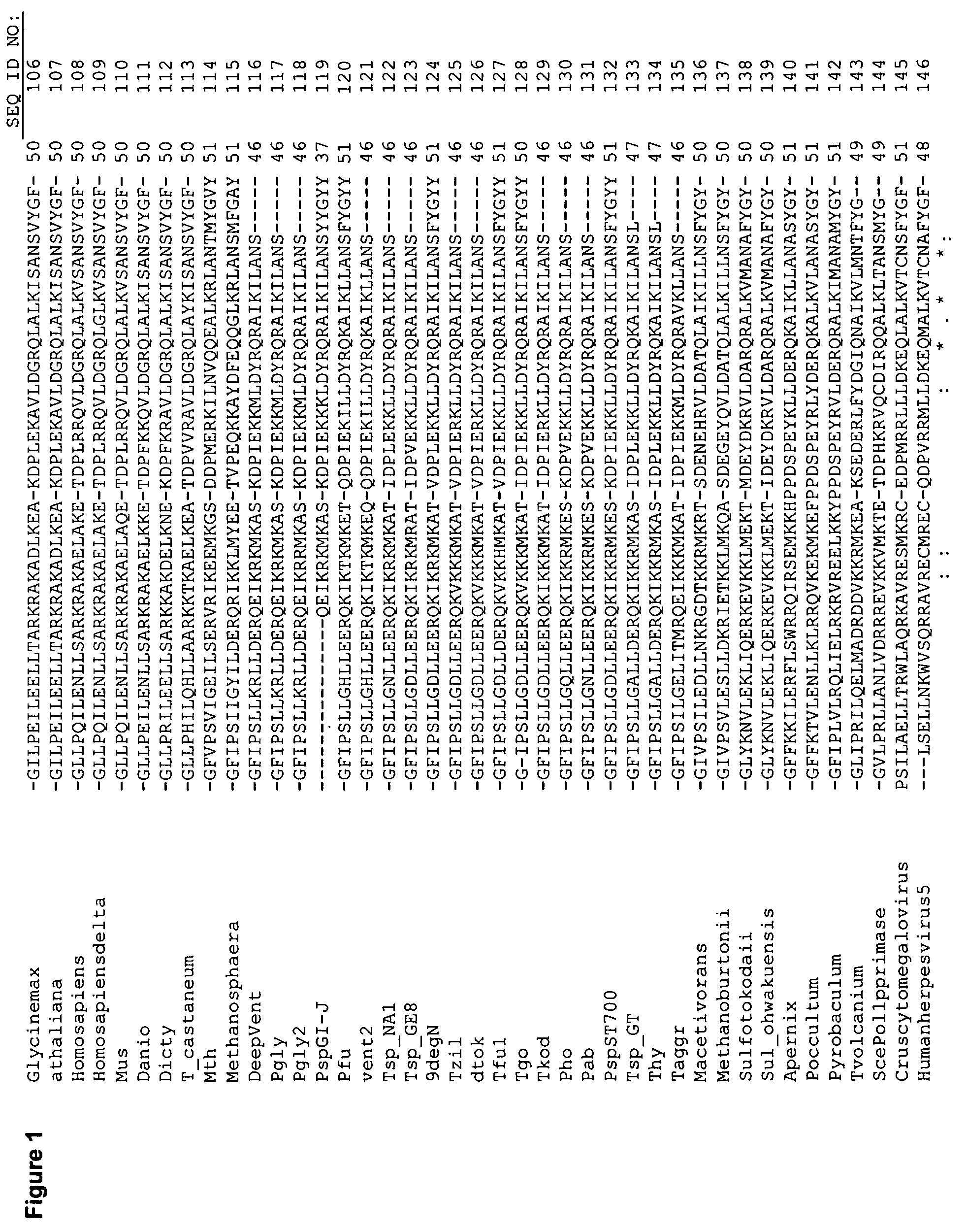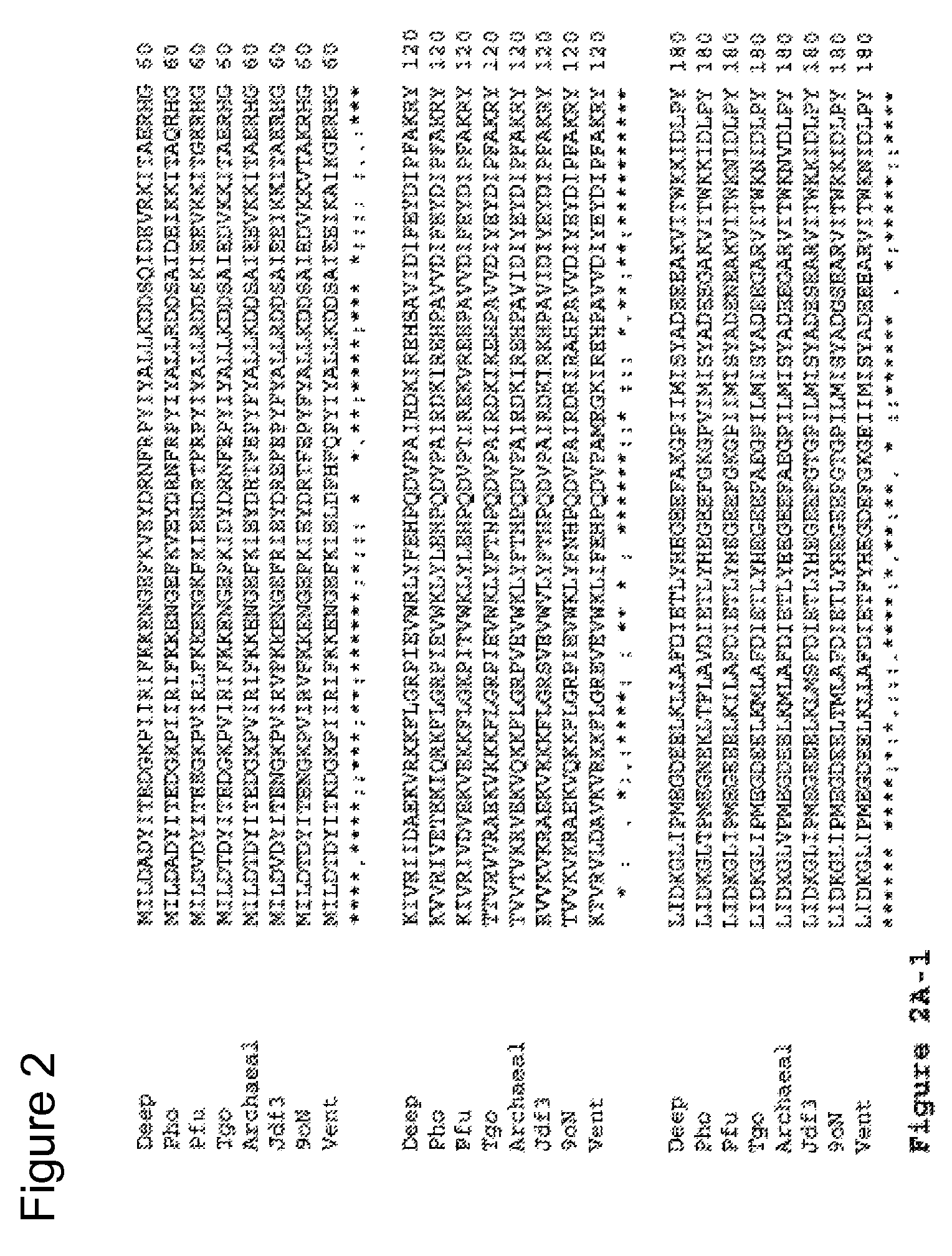Compositions and methods using split polymerases
a technology of polymerases and polymerases, applied in the field of compositions and methods utilizing split polymerases, can solve the problems of chain termination, adversely affecting the performance of techniques or assays, and reducing the efficiency of incorporation of a particular nucleotide, so as to increase the activity of non-natural nucleotides, increase utilization, and increase the activity of non-natural nucleotide analogs
- Summary
- Abstract
- Description
- Claims
- Application Information
AI Technical Summary
Benefits of technology
Problems solved by technology
Method used
Image
Examples
example 1
Preparation of Split Pfu Polymerases by Site-Directed Mutagenesis and Affinity-Tag Purification
[0119]Splits were introduced into Pfu DNA polymerase by site specific mutagenesis using the QuikChange® Multi Site-Directed Mutagenesis Kit from Stratagene according to the Manufacturer's instructions. The primers used are shown in Table I.
[0120]
TABLE ISEQMut.PrimerID NO105GTTAGAGGAAAGACAAAAGATTAAGACATGAAAATGAAG14GAAACTCAAGATCCTATAG106GTTAGAGGAAAGACAAAAGATTAAGACATGAAAAAGAAG15GAAACTCAAGATCCTATAG107CCTCTACATTGACACTGATGGTCTCTATTGAGGAGGCAC16ACAAATGGCAACTATCCCAGGAGGAGAAAGTGAGG
[0121]To make clones 105, 106 and 107, the primers above were used with a plasmid template encoding Pfu D141A / E143A (exo-) DNA polymerase with a C-terminal 6× histidine affinity tag (SEQ ID NO: 100). The 108, 109 and 110 clones were made using a similar DNA template that further contained a Q484R mutation in the Pfu DNA polymerase sequence. The split site in clone 105 was moved one residue up, so that fragment I of clone 1...
example 2
Purification of Split Pfu
[0128]Exo-minus Pfu 4C11 (1-467 V93R / D141A / E143A / A318T) / (468-775 Q484R / V604L / A662V-Ss07d7m) / DNA polymerase was expressed in E. coli from a pET 11 vector. Induced cells were pelleted and resuspended in 40 mM Tris-Cl, 1 mM EDTA, pH 7.5. Protease inhibitors, lysozyme (˜0.25 mg / ml), and 2-mercaptoethanol (10 mM) were added. Cells were lysed by sonication. The extract was heat treated (85° C., 15 min.) to denature heat-labile proteins. NaCl was added to 1M, and polyethyleneimine to 0.175% to precipitate primarily contaminating nucleic acids. Precipitated material was removed by centrifugation. The supernatant was brought to 65% saturation with ammonium sulfate. Precipitated proteins were collected by centrifugation, washed once with 65% saturated ammonium sulfate, then dissolved in Buffer A-1 (40 mM Tris-Cl, 1 mM EDTA, 10 mM 2-mercaptoethanol, pH 7.5). This was dialyzed overnight against Buffer A-1 and then loaded on Q-Sepharose FF that had been equilibrated with...
example 3
Cloning, Expression, and Purification of Separate Pfu Fragments
[0129]Vector Preparation
[0130]The pET21b vector was prepared by amplifying the supercoiled plasmid vector with inverse primers that produced a linear molecule similar to one cut with EcoRI.
[0131]Nine 50 μl reactions were set up using the following parameters:
[0132]
5 μl10x PfuUltra ™ II Fusion HS DNA Polymerase (Stratagene) 0.5 μl100 mM dNTPs (25 mM each, Stratagene)1.25 μlforward primer (100 μM)1.25 μlreverse primer (100 μM) 0.2 μlplasmid DNA (~0.2 ng) 1 μlPfuUltra ™ II Fusion HS DNA Polymerase (Stratagene)40.8 μlH2O
[0133]Cycling parameters were:
[0134]
1 cycle95° C. 1 min30 cycles95° C.45 sec50° C.45 sec72° C. 2 min1 cycle72° C. 5 min
[0135]After amplification, the nine replicates were combined and treated with 5 μl of Dpn I restriction enzyme (Stratagene 4 u / μl) for one hour at 37° C. to destroy the plasmid template. The DNA was purified with StrataPrep PCR kit (Stratagene) according to the manufacturer's recommended p...
PUM
| Property | Measurement | Unit |
|---|---|---|
| temperatures | aaaaa | aaaaa |
| sizes | aaaaa | aaaaa |
| OD | aaaaa | aaaaa |
Abstract
Description
Claims
Application Information
 Login to View More
Login to View More - R&D
- Intellectual Property
- Life Sciences
- Materials
- Tech Scout
- Unparalleled Data Quality
- Higher Quality Content
- 60% Fewer Hallucinations
Browse by: Latest US Patents, China's latest patents, Technical Efficacy Thesaurus, Application Domain, Technology Topic, Popular Technical Reports.
© 2025 PatSnap. All rights reserved.Legal|Privacy policy|Modern Slavery Act Transparency Statement|Sitemap|About US| Contact US: help@patsnap.com



